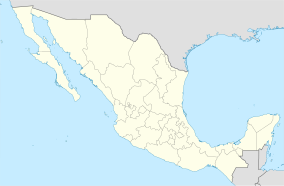| Laguna Madre | |
|---|---|
| Laguna Madre and Río Bravo Delta Biosphere Reserve Laguna Madre and Río Bravo Delta Flora and Fauna Protection Area | |
| IUCN category VI (protected area with sustainable use of natural resources) | |
 | |
| Location | Tamaulipas, Mexico |
| Nearest city | Tamaulipas |
| Coordinates | 25°13′56″N 97°36′29″W / 25.232274°N 97.608032°W / 25.232274; -97.608032 |
| Area | 5,728.08 km (2,211.62 sq mi) |
| Designation | Flora and fauna protection area (national) biosphere reserve (international) |
| Designated | 2005 (national) 2006 (international) |
| Administrator | National Commission of Natural Protected Areas |
| Ramsar Wetland | |
| Official name | Laguna Madre |
| Designated | 2 February 2004 |
| Reference no. | 1362 |
Laguna Madre is a coastal lagoon in Northeastern Mexico. It extends along the coast of Tamaulipas for over 200 km, from the Río Bravo Delta on the north to the mouth of the Soto la Marina River near La Pesca in the south. Laguna Madre is separated from the Gulf of Mexico on the east by a number of barrier islands, including Barra Los Americanos, Barra Jesús María, and Barra Soto la Marina, and is bounded on the west by the Tamaulipan mainland. It is located in the municipalities of Matamoros, San Fernando, and Soto la Marina.
There is another Laguna Madre in the United States, which extends north from the Río Bravo Delta to Corpus Christi Bay and the city of Corpus Christi in southern Texas. Together the two lagoons and delta form a single ecological unit approximately 275 miles (443 km) in total.
Characteristics
The Laguna Madre is very shallow, with an average depth of only 0.9 m (3.0 ft). The lagoon is connected to the ocean by only two narrow inlets, so the tidal range – which is already minor in this part of the Gulf of Mexico – is negligible. Atmospheric effects are much more important than tides in its circulation; its weak currents generally follow the prevailing winds, and these winds can influence the water level by as much as a meter.
Oceanographically, the Laguna Madre is considered a hypersaline lagoon; this indicates that it is usually much saltier than the ocean, due to being nearly landlocked in a semiarid environment. This is because its salinity can vary wildly depending on rainfall and freshwater inflow, from as high as 120 ppt (12%) – over three times saltier than the ocean – to as low as 2 ppt (0.2%) after a heavy rain.
Flora and fauna
According to the National Biodiversity Information System of Comisión Nacional para el Conocimiento y Uso de la Biodiversidad (CONABIO) in Laguna Madre and Delta del Río Bravo Flora and Fauna Protection Area there are over 1,515 plant and animal species from which 72 are in at risk category and 51 are exotics.
Aquatic habitats include mangroves and large areas of seagrass beds with Halodule wrightii and other species.
Laguna Madre is one of the most important bird wintering habitats in Mexico. It is home to 26 species of waterfowl, including grey plover (Pluvialis squatarola), sanderling (Calidris alba), least sandpiper (Calidris minutilla), and piping plover (Charadrius melodus). Populations of redhead (Aythya americana) and northern pintail (Anas acuta) number over 100,000 individuals. There are 144 resident bird species, including both waterbirds and terrestrial birds. It is on the Gulf migratory route, an important migration route for water birds, songbirds, and birds of prey.
Upland areas are part of the Tamaulipan pastizal, a mosaic of grassland and semi-arid shrubland. Characteristic shrubs include mesquite (Prosopis glandulosa), blackbrush (Acacia rigidula), and Castela tortuosa. It includes some of the best-preserved areas in the Mexican portion of the pastizal, and serves as a wildlife corridor for large mammals like jaguar, ocelot, oncillo, puma, and lynx.
Conservation
Thanks to lobbying and studies done by organizations such as Pronatura Noreste, universities, local governments, and other organizations, with the aid of local communities, in April 2005 the Mexican government declared Laguna Madre and the Río Bravo Delta a flora and fauna protection area. The 1.4 million acres (5,700 km) under legal protection are in the municipalities of Matamoros, San Fernando and Soto la Marina, in the state of Tamaulipas. In 2006 UNESCO declared the area an international biosphere reserve.
References
- ^ UNEP-WCMC (2021). Protected Area Profile for Laguna Madre y Delta del Río Bravo from the World Database of Protected Areas. Accessed 4 October 2021.
- ^ "Laguna Madre". Ramsar Sites Information Service. Retrieved 25 April 2018.
- Tunnell, Jr. John W. and Frank W. Judd. editors. (2002). The Laguna Madre of Texas and Tamaulipas. Texas A&M University Press, College Station, Texas. xxi, 346 pp. ISBN 1-58544-133-3
- ^ Gross, Grant M. Oceanography: A View of the Earth. Englewood Cliffs: Prentice-Hall, Inc., 1972. pp. 312-314. ISBN 0-13-629659-9
- Comisión Nacional para el Conocimiento y Uso de la Biodiversidad. "Enciclovida (2022). Área de Protección de Flora y Fauna Laguna Madre y Delta del Río Bravo". Retrieved August 26, 2022.
- Comisión Nacional para el Conocimiento y Uso de la Biodiversidad. "Naturalista (2022). APFF Laguna Madre y Delta del Río Bravo, Tamaulipas". Retrieved August 26, 2022.
- ^ "Laguna Madre y Delta Río Bravo Biosphere Reserve, Mexico". UNESCO, December 2018. Accessed 4 October 2021.
- The Nature Conservancy in Mexico – Laguna Madre Archived February 18, 2005, at the Wayback Machine
Sources
- Laguna Madre from the Handbook of Texas Online
- “Laguna Madre – A New Day… Un Nuevo Día” (PDF) (Accessed 12/09/19) – US Fish and Wildlife Service
- The Nature Conservatory – “Laguna Madre” (Accessed 2/25/08)